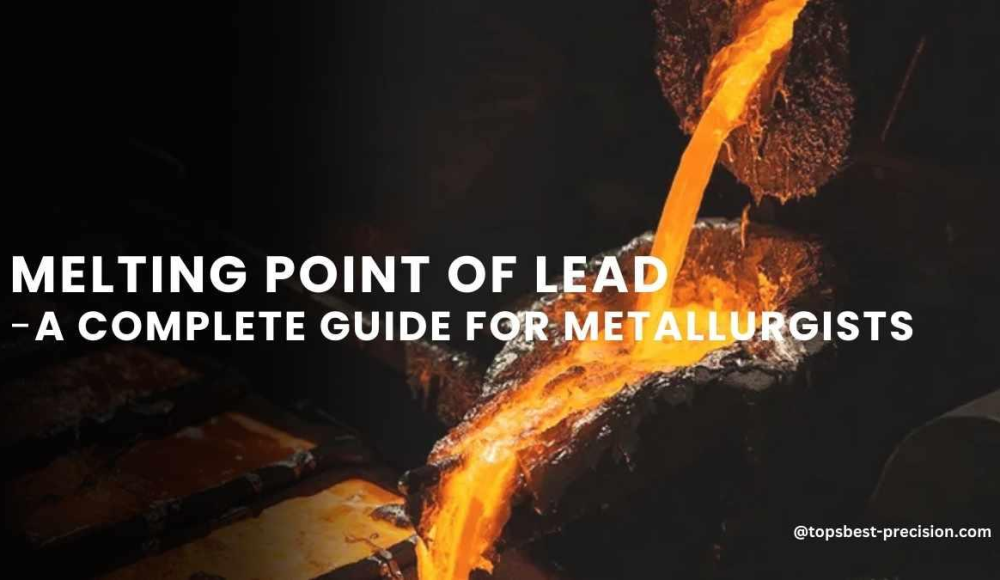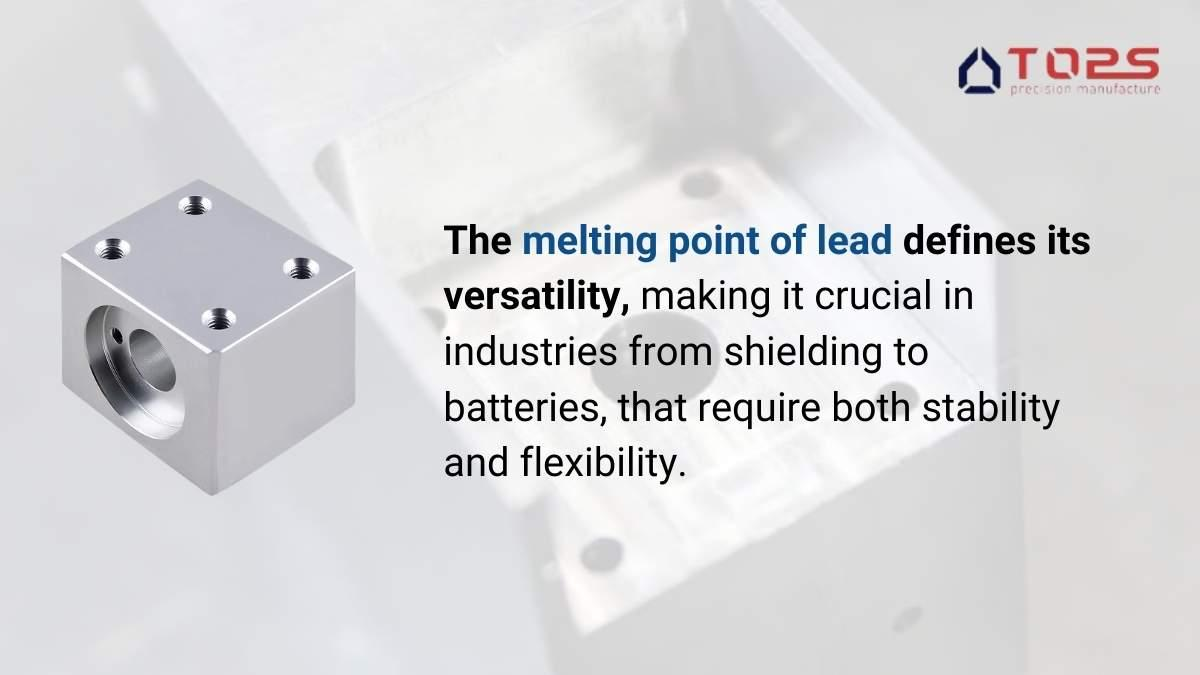¿No estás seguro del punto de fusión del plomo?? Este factor es muy esencial para sus proyectos de metalurgia.. Es importante comprender cómo elegir el material adecuado a utilizar.. Curiosamente, No hacer esto le deja con el potencial de retrasar los proyectos.. La maleabilidad del Plomo afecta a las operaciones de fundición y soldadura.. Entonces, Ahora analicemos por qué esta temperatura es importante..
¿Cuál es el punto de fusión del plomo??
La temperatura de fusión del plomo suele ser más baja., acerca de 327.5 C o 621.5 F. El plomo cambia de fase de sólido a líquido, a esta temperatura. en esta propiedad, Los metalúrgicos necesitan saber cómo reacciona el plomo al calor para tomar las decisiones correctas.. Es útil al hacer aleación., fundición, o soldadura ya que permite el control del calor al que se funde el metal/aleación..
El plomo se utiliza en soldaduras y baterías a base de plomo porque tiene un punto de fusión relativamente bajo.. También encuentra aplicación en industrias que necesitan control de temperatura para la calidad de los productos que se producen.. El conocimiento también ayuda a los profesionales a prevenir pérdidas materiales además de minimizar los errores de producción..
Factores que afectan el punto de fusión del plomo
El proceso de flotación del plomo requiere comprender el punto de fusión, ya que se ve afectado por varios factores.. La siguiente sección revela factores tan cruciales: incluido el tipo de aleación, impurezas, tasa de calentamiento, presión, y la distribución de la temperatura influyen en el momento en que el plomo se derretirá.
1. Composición de la aleación
Usando aleaciones afecta el punto de fusión del plomo. Se pueden obtener ligeros aumentos en el punto de fusión si el compuesto se mezcla con metales como el antimonio.. La proporción de plomo con respecto a la cantidad de elementos de aleación determina las características generales de fusión..
2. Presencia de impurezas
La presencia de elementos no deseados como el azufre., y arsénico, Disminuye el punto de fusión del plomo.. Cualquier cambio en el grado de contaminación afecta la temperatura a la que el plomo cambia de sólido a líquido y, por tanto, afecta su papel en las industrias..
3. Tasa de calentamiento
El tiempo necesario para calentar el plomo determina cómo se funde.. La fusión es más rápida cuando se realiza a altas temperaturas mientras que es lenta., El calor constante permite un proceso más uniforme. Particularmente, Es cierto en el casting y otros usos metalúrgicos altamente especializados..
4. Presión
A presiones más altas, El punto de fusión aumenta, y las presiones más bajas pueden disminuir el punto de fusión. Esto es específicamente crucial cuando un plomo está expuesto a sistemas de alta o baja presión.
5. Gradientes de temperatura
La distribución de temperatura dentro del material puede ser una causa de la variación. La uniformidad del calor es imprescindible cuando la fusión conduce para evitar la estructura de la ruptura de plomo, especialmente cuando se trabaja en cantidades a granel..
Comparación del punto de fusión del plomo con otros metales
La siguiente tabla proporciona una comparación clara de los puntos de fusión de liderazgo y Otros metales a través de tres escalas de temperatura: Celsius, Fahrenheit, y Kelvin.
| Metal | Celsius (°C) | Fahrenheit(°F) | kélvin(° K) |
| Dirigir | 327.5°C | 621.5°F | 600.65 k |
| Aluminio | 660.3°C | 1220.5°F | 933.45 k |
| Cobre | 1084°C | 1983.2°F | 1357.15 k |
| Oro | 1064°C | 1947.2°F | 1337.15 k |
| Hierro | 1538°C | 2800.4°F | 1811.15 k |
| Plata | 961.8°C | 1763.2°F | 1234.95 k |
| Zinc | 419.5°C | 787.1°F | 692.65 k |
| Titanio | 1668°C | 3034.4°F | 1941.15 k |
| Níquel | 1455°C | 2651°F | 1728.15 k |
Cómo derretir plomo?
El metal de plomo sufre un estricto proceso de fusión, y requiere una manera adecuada. El método implica calentar el plomo crudo hasta que comience a derretirse. Entonces, El material fundido se manipula para la fundición., aleación, o dando forma.
1. Preparación de plomo
Para conseguir un plomo de buena calidad debes tener mucho cuidado al recoger el plomo y antes de fundirlo.. Las impurezas en la superficie del material pueden afectar la calidad del metal cuando se funde.. Entonces, La limpieza previa es importante para aumentar los niveles de pureza del producto final..
2. Calentar el plomo
El plomo debe calentarse hasta su punto de fusión., ser 327.5 °C (621.5°F). Se puede hacer usando un horno., crisol, o calentamiento por inducción. En este caso, El cable debe calentarse lentamente para evitar salpicaduras desiguales..
3. Controlar la temperatura
La temperatura debe mantenerse constante todo el tiempo.. Cuando el plomo se funde, se debe controlar la temperatura para garantizar el estado fundido del plomo y evitar la solidificación.. También puede causar oxidación y contaminación si se sobrecalienta..
4. Eliminación de impurezas
Cuando el plomo se derrite, Óxidos y otras formas de contaminación superficial en el metal líquido.. Estos pueden eliminarse mediante procedimientos de desnatado y fundente.. Además, También se pueden emplear agentes fundentes para dejar el plomo fundido limpio y libre de asperezas..
5. Moldeo o fundición
Después, El plomo se vierte en moldes para darle diversas formas y productos.. Por lo que se debe controlar su flujo para evitar derrames e irregularidades en la superficie del molde resultante..
6. Enfriamiento y solidificación
Una vez vertido, fragua rápidamente porque el plomo tiene un punto de fusión relativamente bajo.. La velocidad de enfriamiento puede tener un impacto en algunas características del producto final., entonces, El proceso de enfriamiento debe regularse en aplicaciones industriales..
Aleación de diferentes grados de plomo
Los clientes potenciales de diferentes grados implican diferentes elementos.. La pureza del plomo determina su comportamiento en el proceso, su punto de fusión, y su aplicación en diversas industrias.
1. Plomo puro (99.9% Dirigir)
Se ha encontrado que el plomo puro contiene un alto grado de pureza y un punto de fusión relativamente bajo de 327.5 ° C (621.5°F). La calificación también comprende una buena característica de flujo que permite procesarse de manera fácil y uniforme.
2. Aleaciones de plomo
Las aleaciones de plomo comprenden plomo (Pb-sn) y antimonía de plomo (PB-SB) aleaciones. El punto de fusión de la aleación varía con la composición. Dichas aleaciones se utilizan para fines especiales, por ejemplo, en Soldining-PB SN o para placas de batería-PB SB.
- Plomo (Pb-sn) Aleación: Los puntos de fusión dependen de la relación, Pero está en el rango de 180-300 0C (356-572 F) Debido a la lata.
- Antimonía (PB-SB) Aleación: En comparación con el plomo puro, esta aleación tiene un punto de fusión más alto, Generalmente que va desde 325 a 340 grado Celsius (617 a 644 F) dependiendo del porcentaje de antimonio.
3. Plomo Reciclado
Cable, utilizado en la creación de plomo reciclado, puede contener impurezas que pueden distorsionar sus características de fusión. Estos elementos no deseados deben eliminarse mediante el proceso de fundente.. Así el plomo fundido no cambia sus características..
4. Plomo para Baterías (Pb-Ca)
Plomo empleado en la fabricación de baterías., particularmente en baterías de plomo-ácido, puede contener calcio (Pb-Ca) y otras adiciones de aleación. Sin embargo, el grado de plomo sólido puede fluctuar un poco, pero normalmente se encuentra dentro de unos pocos grados del valor del plomo puro de aproximadamente 327,5 °C.. Como ocurre con cualquier proceso térmico., Se debe tener cuidado durante el proceso de fusión para evitar el inicio de reacciones secundarias no deseadas..
5. Plomo para blindaje radiológico
El plomo de blindaje se utiliza en la protección radiológica.. Generalmente, Es químicamente puro y puede contener pequeñas trazas de adiciones de aleación.. Estos grados de plomo generalmente se vuelven a fundir a temperaturas ligeramente inferiores a las del plomo puro., aunque controlado para evitar la oxidación.
Papel del punto de fusión del plomo en diversos sectores
Propiedades del plomo, incluyendo su punto de fusión, impactar varios campos. Estas propiedades afectan la forma en que las industrias gestionan y transforman el plomo.. Comprenderlos ayuda a prevenir errores y aumenta la eficiencia.
1. Soldadura y Electrónica
El plomo es popular en la soldadura.. La baja temperatura de fusión facilita la soldadura de componentes electrónicos sin riesgo de dañar las partes delicadas de los componentes.. Proporcionan conexiones eléctricas seguras en placas de circuitos..
2. Baterías de plomo-ácido
En la fabricación de baterías, El plomo tiene un punto de fusión bajo para facilitar la aleación de las placas de la batería.. Se debe mantener la temperatura adecuada para evitar la oxidación., y a su vez, degradar la calidad de la placa.
3. Blindaje radiológico
El plomo se utiliza como protección contra la radiación debido a su alta densidad.. Su bajo punto de fusión permite su uso para producir láminas gruesas.. Da una garantía de protección., Especialmente en industrias médicas y otras.
4. Fundición y moldeado
La fundición de plomo en moldes es bastante fácil. Proporciona la posibilidad de obtener formas complejas y piezas pequeñas en los tamaños necesarios.. El uso más frecuente del plomo se encuentra en las tuberías, accesorios para el hogar, y bronces ornamentales.
5. Fabricación de municiones
La pureza del plomo es crucial en la fabricación de municiones debido a su punto de fusión. Facilita el moldeo de balas de tamaño y peso estándar.. El proceso garantiza proyectiles de alto rendimiento para armas de fuego.
Resumen
El punto de fusión del plomo es crucial para varios usos industriales. Influye en actividades como soldar, fundición, y fabricación de baterías. La comprensión de dicha propiedad ayuda a lograr resultados precisos y alta calidad. Manteniendo las temperaturas correctas, Se controlan las propiedades y la uniformidad de la aleación derretida.
En Tapas de precisión Ofrecemos clientes potenciales de alta calidad para sus requisitos precisos.. Es una garantía de que cada proyecto en el que trabajamos se maneja profesionalmente y con mucha atención al detalle para cumplir con los servicios de más alta calidad que ofrecemos..





1 pensamiento en “Punto de fusión del plomo – Una guía completa para metalúrgicos del metal”